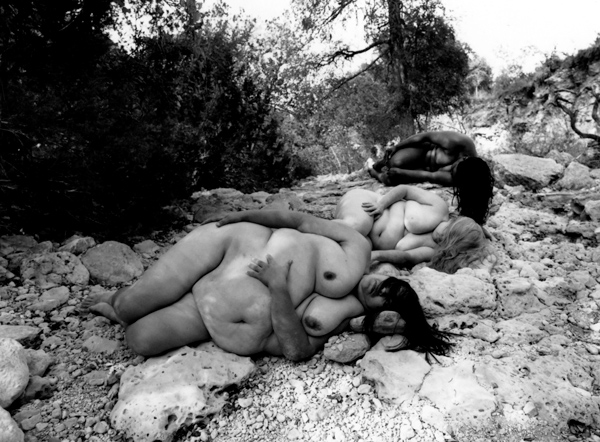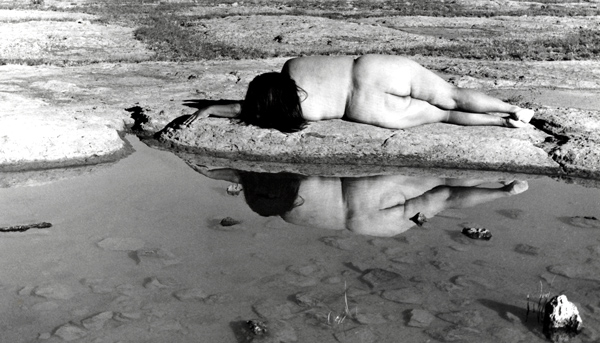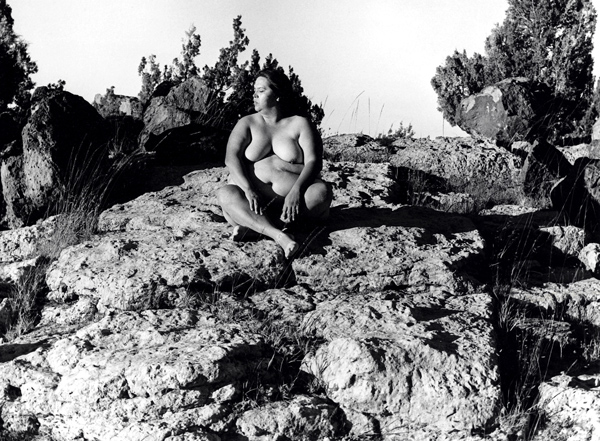Monday, February 26, 2018
Jessica Kolkmeier reviews Gillian Wearing
Wearing's work, I think, would draw anyone's attention due to the sheer extreme nature of her process. Each photo in her Album series portrays Gillian herself, under a waxy, almost disturbing realistic mask of each of her closest members. With the help of these masks, appropriate backdrop, specific clothing and styling, she is able to transform herself into the likeness of each person. This technique literally brings "take a walk (or photo) in someone else's shoes" to life. Personally, it's interesting to me because seeing old photos of my parents always makes me wonder what I would've been like in that era, as well as draw fantasies of what they were like. Often I've tried to imagine their past lives as mine, and this project really brings that idea forward. In a statement, she mentions that she purposely chose younger versions of her parents so that they seem unaffected by life's pressures that come later on. Seeing as Wearing herself was young at the time of each photo, further meshes her life with that of each person she is portraying.
Jessica Kolkmeier reviews Hellen Van Meene
Hellen Van Meene's work attracted me because it's almost the opposite of what I've always gone for. Her portraiture subjects are adolescent, puberty stricken boys and girls, unsure of how to act in front of the camera. While some seem uncomfortable and certainly out of place in a fine art photograph, others just seem unaware, innocently posing for Van Meene as if it's a school project. The lighting varies in each photo, some inside and some outside, though she always utilizes soft natural light. When I views these photos, tension is the first thing that comes to mind. However, as you realize the nature of the subjects, you almost get a sense of empathy, and remember the struggles that come with such a transformative age.
BELINDA FUENTES REVIEWS LESLIE HALL BROWN
Photographer, Leslie Hall Brown discusses
a controversial subject matter in her series, Not My President. Although, not particularly involved in politics,
like many others, and myself, Brown used this series as a response and
therapeutic measure. Not planning to share this series, in doing so Brown was
invited into a community with shared beliefs and frustration over the current
political power. This process showed Brown the power of art to unite the public
and hopefully change it. Essentially, Brown digitally manipulates found
photographs of Donald Trump and creates surreal imagery often seen in her work
including images of Nazi soldiers, other political figures and animals. Additionally,
text is another important aspect to this work in plainly sharing opinions. Not My President is somewhat a game of
eye spy, locating the imagery and text, using context and concluding Brown and
much of the population’s commentary. Clearly Brown’s work is commenting on
Donald Trump’s presidency, as a political figure and as a person. This series
makes numerous comments such as Trump’s immaturity, his lack or morals, narcissism
and so on. The images are ordered specifically in the order they were made to
act as a timeline of his presidency. While at first appearing humorous, the
commentary is rather serious.



Friday, February 23, 2018
BELINDA FUENTES REVIEWS MARCUS DESIENO
Marcus DeSieno works mainly in the
darkroom with alternative processes seen in his series Parasites in which he
uses a dry plate method. DeSieno points out that with these processes, it
differs each time and individual characteristics appear such as his
fingerprints. Using science, DeSieno also combines this interest with the
invisible to create works that challenge his fears (being a germaphob). In this
specific series, DeSieno obtained contacts with laboratories, to shoot a
variety of parasites. Although they appear large, the image is actually a micro
shoot of these specimens. Fusing new imaging systems and old photographic
processes, DeSieno uses the Scanning Electron Microscope to create the notion
these specimens are larger than they before exposing it on a dry plate.
Further, he exposes on a dry plate to avoid the coldness of a microscope image.
The combination of the parasites as subjects and the photographic process of a
dry plate are fitting in that the background of the images have a filmy substance
from the chemicals that act as the “juice” from which the specimens could
derive from. The way in which DeSieno positions these specimens gives them a
sense of character and gives them life, although they are not and still forms. Overall,
DeSieno uses science including alternative processes and microscopes to create
his series.



Thursday, February 22, 2018
Burk Frey reviews Michiko Kon
Michiko Kon (1955-) is a contemporary still life photographer from Kanagawa Prefecture, Japan. She attended Tokyo Photographic College from 1978-80 and has since earned collections and shows worldwide. Kon is best known for her monochrome images centered on surprising (and sometimes grotesque) juxtapositions of human-made objects with sea creatures. They address life and death, standards of aesthetics, and sexuality.
Her newer work is less obvious, leaving more interpretation up to the viewer; nonetheless, I still found that her older images are more striking “objects of interest” even as they lack in ambiguity. Three of those older images are below, while a fourth one I liked (The Red Boot) is transitional while still hewing much closer to the old style.
I suspect that these images were even more arresting / shocking when they were created in the 1980s, but they still take me out of my comfort zone.
There is a certain “ick” factor in them, which is made more interesting because it directly contrasts with a feeling of mundanity that comes right before it. After all, these seem to be normal objects… but at second glance, Kon has twisted their presentation in some dark fashion or other. With a hint of sadism, she seems to enjoy this back-and-forth pushing and pulling of viewers’ expectations. I think the images succeed on that merit.
Her newer work is less obvious, leaving more interpretation up to the viewer; nonetheless, I still found that her older images are more striking “objects of interest” even as they lack in ambiguity. Three of those older images are below, while a fourth one I liked (The Red Boot) is transitional while still hewing much closer to the old style.
 |
| Salmon, Flatfish, and High Heel (1987) |
 | |||||||||||||
| Goldfish, Salmon Roe, and Toothbrush (1985) |
 |
| Cuttlefish and Sneaker (1989) |
I suspect that these images were even more arresting / shocking when they were created in the 1980s, but they still take me out of my comfort zone.
There is a certain “ick” factor in them, which is made more interesting because it directly contrasts with a feeling of mundanity that comes right before it. After all, these seem to be normal objects… but at second glance, Kon has twisted their presentation in some dark fashion or other. With a hint of sadism, she seems to enjoy this back-and-forth pushing and pulling of viewers’ expectations. I think the images succeed on that merit.
 |
| The Red Boot (1995) |
Wednesday, February 21, 2018
Burk Frey reviews Pablo Ortiz Monasterio
Pablo Ortiz Monasterio is an internationally successful contemporary photographer. Born in Mexico City in 1952, much of his work deals with the culture of his homeland, ranging from indigenous lore to current events. An early, decisive influence was French street photographer Bernard Plossu, who had created photos in Mexico (among many other countries). Monasterio is considered one of Mexico’s preeminent art photographers.
I was introduced to Monasterio’s work through his 2016 book, Desaparecen? (They’re missing?), which confronts the Ayotzinapa College mass kidnapping of a few years previous (2014).
 |
| Desaparecen? (cover) (2016) |
In this event, 43 student protesters were taken, turned over to a local crime syndicate, and presumed killed, possibly with the assistance of Mexican Federal Police. The kidnapping ignited nationwide protests and international scandal.
The book is a sociopolitical work bravely, in my opinion, and unapologetically addressing / elegizing the disappearance of these students. Looking through the pages, we can sense Monasterio’s pain and righteous anger through his masterful photography and layouts. Along with relevant phrases, each page contains the number 43 on it, and the book opens and closes with the “missing person” portraits of each student. In this way, he begs us to remember what happened.
There’s a further detail that I thought was both touching and subversive. The book was created in two editions, one as a typical art-world monograph, finely printed and bound; and one for $12, stapled and printed on inexpensive matte paper, so that it could be appreciated locally in the community where the students were kidnapped.
 |
| Desaparecen? (2016) |
 |
| Desaparecen? (2016) |
Burk Frey reviews Ross Faircloth
Ross Faircloth (born 1986 in Dallas, Texas) is a photographer working in pinhole and non-lens styles. His images are unified by a desire to strip analog photography down to what he calls the basics — light, photo paper, and chemistry — to remove the artform from more documentarian efforts. He also sometimes incorporates pop imagery and mark making into his work, which runs the gamut from abstract to fully representational. This last bit was inspired by the constructed darkroom work of 20th century photographer Joel-Peter Witkin.
I don't think that Ross' work is the type of photography that I would naturally gravitate towards (though a few of his images are appealing and quite successful), and I am drawn to the idea that an artist with such a similar background as myself — born the same year in the same city attending a BFA program at a school in the same system — could have such divergent processes and interests.
 |
| A Dark Place (Dark Grandeur series) |
 |
| From Fault Lines series |
Of course these are all surface-level similarities; our childhoods, lived experiences, influences, and personalities are likely quite dissimilar. Yet I am still interested in how two artists of the same age, educational background, and neck of the woods could be drawn to these different sides of photography. Ross appears fascinated by the physical craft of darkroom, almost as a goal unto itself. I see darkroom techniques as tools to get art and story into the world — wonderful tools, but tools nonetheless. Neither approach is better nor worse; instead, other factors determine if the art we make is worthwhile.
 |
| Developer and Folds (Dark Grandeur series) |
It follows, then, that (to me) Faircloth’s strongest work is The Night I… (2010), excerpted below. This project has much more narrative “meat” on it; text is taken from the parole hearing of John Lennon’s murderer and bound with photos into book format. Punctuation and formatting were removed, and the font size shrinks in size every page turn, revealing more text. The massive colophon on the last page detracts, but overall I love the idea and execution of this work.
 |
| The Night I... spread 5 (2010) |
 |
| The Night I... spread 8 (2010) |
 |
| The Night I... spread 11 (2010) |
Tuesday, February 20, 2018
Jesusa Vargas reviews Laura Aguilar
Laura Aguilar is a, mostly, self-taught photographer from California. Her primary work is portraiture, focusing on the human form. She challenges societal norms and idealistic views of beauty, sexuality, gender, and race. Laura is quoted in her artist statement, "my photography has always provided me with an opportunity to open myself up and see the world around me. And most of all, photography makes me look within". She has been photographing since the late 1970s and has, since, made connections with the Chicano Art community in LA. Laura identifies with the Latina and LGBT community and this plays a huge influence in her body of works.
Three photographs that caught my interest are black and white photos taken in the late 1990s. All three photos include Laura in the image and in all three of the photos she is nude. In this selection, I feel she is speaking to the human body, most particularly hers, and the connection to nature at the same time celebrating the natural beauty of her body. I also feel the photographer is expressing her connection to two identities, being that she is both Mexican-American and Irish background. Laura captures the curves and creases of her own body within the landscape and creates photographic compositions that are bold and empowering for women of color. In each image below, the artist demonstrates a sense of belonging to her surroundings and among other women, as seen in the first image.
Laura still has exhibitions, most recently at the Vincent Price Museum and has displayed her works in San Antonio in an art residency at Artpace.
http://artpace.org/artists_and_curators/laura-aguilar
https://www.vielmetter.com/artists/laura-aguilar/biography.html
https://www.cla.purdue.edu/waaw/Corinne/Aguilar.htm

Motion #56, 1999, gelatin silver print; all images courtesy of the artist and the UCLA Chicano Studies Research Center, artwork ©Laura Aguilar.

Nature Self-Portrait #10, 1996, gelatin silver print

Laura Aguilar, Nature Self-Portrait #11, 1996, Gelatin silver print, 16 x 20 inches
Three photographs that caught my interest are black and white photos taken in the late 1990s. All three photos include Laura in the image and in all three of the photos she is nude. In this selection, I feel she is speaking to the human body, most particularly hers, and the connection to nature at the same time celebrating the natural beauty of her body. I also feel the photographer is expressing her connection to two identities, being that she is both Mexican-American and Irish background. Laura captures the curves and creases of her own body within the landscape and creates photographic compositions that are bold and empowering for women of color. In each image below, the artist demonstrates a sense of belonging to her surroundings and among other women, as seen in the first image.
Laura still has exhibitions, most recently at the Vincent Price Museum and has displayed her works in San Antonio in an art residency at Artpace.
http://artpace.org/artists_and_curators/laura-aguilar
https://www.vielmetter.com/artists/laura-aguilar/biography.html
https://www.cla.purdue.edu/waaw/Corinne/Aguilar.htm

Motion #56, 1999, gelatin silver print; all images courtesy of the artist and the UCLA Chicano Studies Research Center, artwork ©Laura Aguilar.

Nature Self-Portrait #10, 1996, gelatin silver print

Laura Aguilar, Nature Self-Portrait #11, 1996, Gelatin silver print, 16 x 20 inches
Monday, February 19, 2018
Gabi Cruz reviews Jeff Wall
Important photographer Jeff Wall makes massive color photograph
that appear to express how people interact in their daily life, but, are actually
large production. Gripped in the cinema of the postwar era, especially the unusually
chronicle arrangement of Neo-Realism, his acclaimed work includes making complex
visual themes of telling stories, which he captures and then exhibit in
wall-mounted lightboxes. “I wanted to exaggerate the artificial aspect of my
work as a way to create a distance from the dominant context of reportage, the
legacy of Robert Frank and the others,” Wall explains. “I saw something else
in photography, something to do with scale, with color and with construction,
which might be valid along with the more established values that had come down
from the 19th century and had been extended by the great photographers of the
20th century.” Wall’s work is a wide range, and for many years has also includes
smaller, documentary photographs and, since 1997, black-and-white pictures.
Subscribe to:
Posts (Atom)





